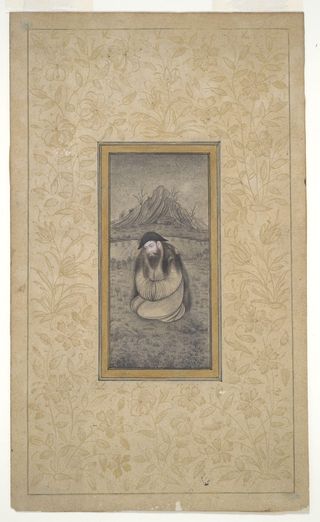Dervish Seated in a Mountainous Landscape

Dervish Seated in a Mountainous Landscape, Iran, 20th century
Accession no. 2001.138.11
Yale University Art Gallery
This painting is a 20th-century depiction of a Dervish seated in a wilderness landscape with a lake and a tall mountain behind him. He is in a kneeling position, with folded hands and a lowered gaze suggesting that he is in a state of deep introspection. The painting itself is small, with the dimensions of 11.6 x 5.5 cm. There is an ornate frame with gold flowers and leaves around it that increases the dimensions of it to 48.9 x 36.2 cm. This painting was made with ink and opaque watercolor on paper. The background wilderness is drawn with ink, and the only color seen is on the figure. The details are so fine, that it can be inferred that this was done with a single-haired brush. The watercolor is only on the figure’s face, giving it pink and white coloring. This painting was done in the 20th century and attributed to Iran. There is no signature or known artist, and it is possible that this painting was done by multiple people. It is common for Persian paintings to be a collective effort, with people skilled in different aspects doing separate portions of the painting, reflecting a collaborative approach that is common in many other aspects of Persian artistic traditions.
The figure in this painting is depicted in meditation or introspection. A dervish is a Sufi Muslim, known for their ascetic lifestyle, devotion to God, and practice of mysticism. The clothing symbolizes humility and detachment from material possessions. You can see examples of this in this painting with the figure’s black hat and large cloak. In Persian paintings, sleeves often serve as a metaphor for the emotional state of the wearer. They can express contemplation, reverence, trepidation, and intoxication. Compared to other Persian paintings, this has a very dull and dark color palate. The only color seen is on the figure’s face, but other than that, it is all gray with the neutral color of the paper showing through. These colors emphasize the lifestyle of simplicity, humility, and detachment from worldly pleasures.
The detail and meaning this painting can hold is immense while still being small enough to fit in the palm of a hand. This painting is a testament to the spiritual traditions and artistic heritage of Persian culture. Through its intimate scale and detail, it invites viewers to contemplate, with the figure of the dervish embodying the search for God and truth. Against the wilderness background, this painting portrays Sufi mysticism and evokes a sense of tranquility. As viewers engage with the artwork, they are brought into the quest for spiritual fulfillment and enlightenment.
Sources:
Diba, Layla S. “Persian Painting in the Eighteenth Century: Tradition and Transmission.” Muqarnas 6 (1989): 147–60.
Fellinger, Gwenaëlle, and Carol Guillaume. Revealing the Unseen: New Perspectives on Qajar Art. Edited by Gwenaëlle Fellinger and Melanie Gibson. Gingko, 2021.
